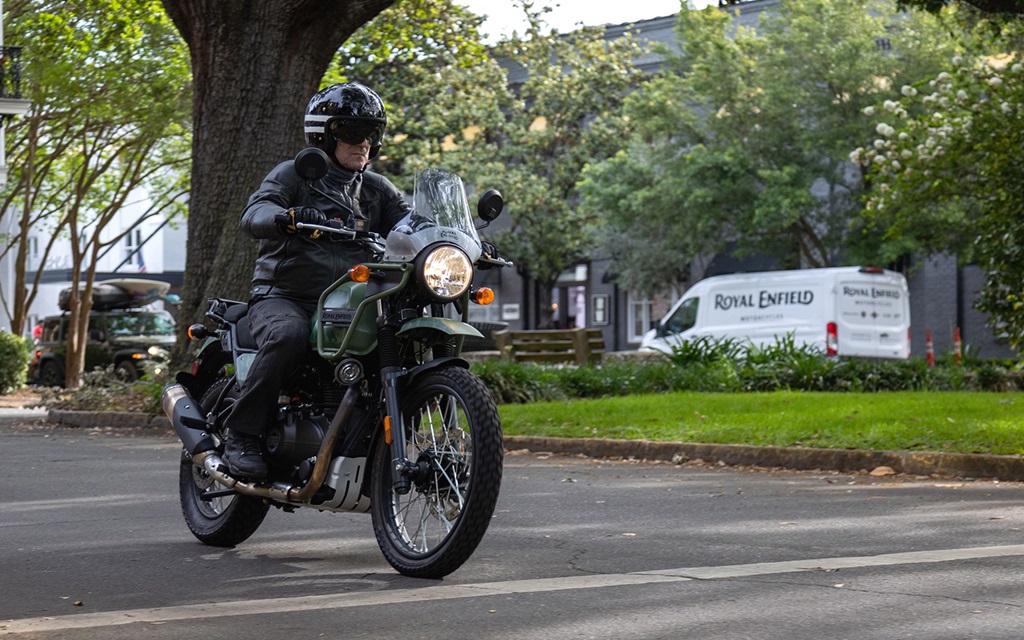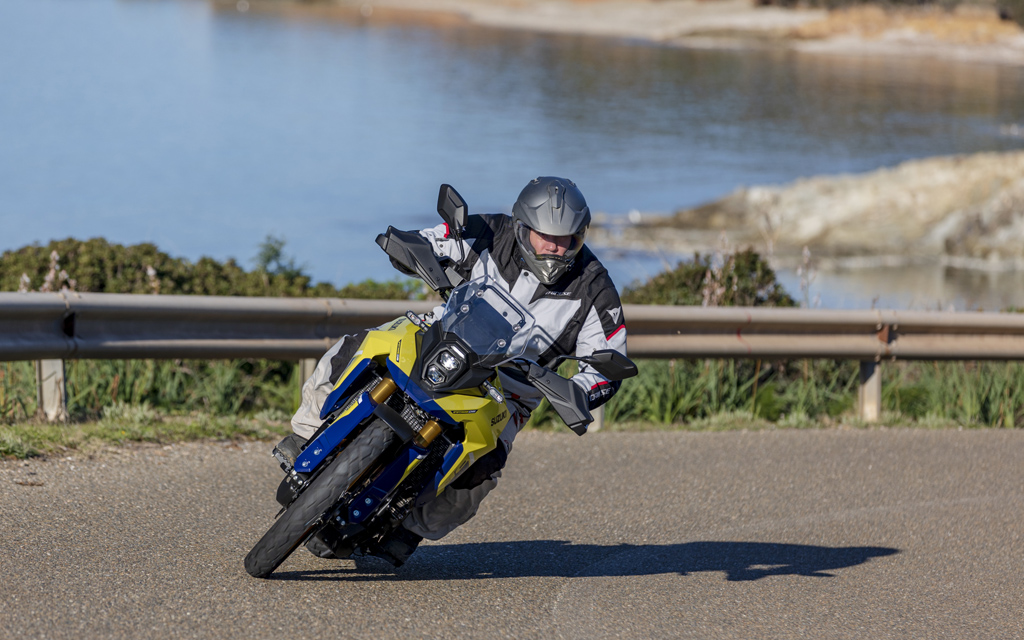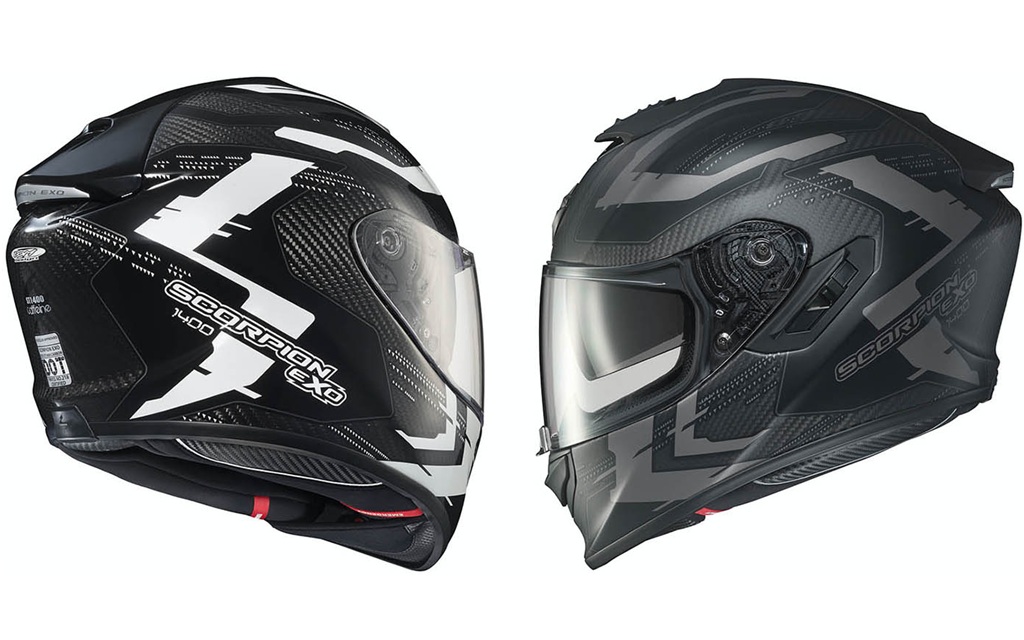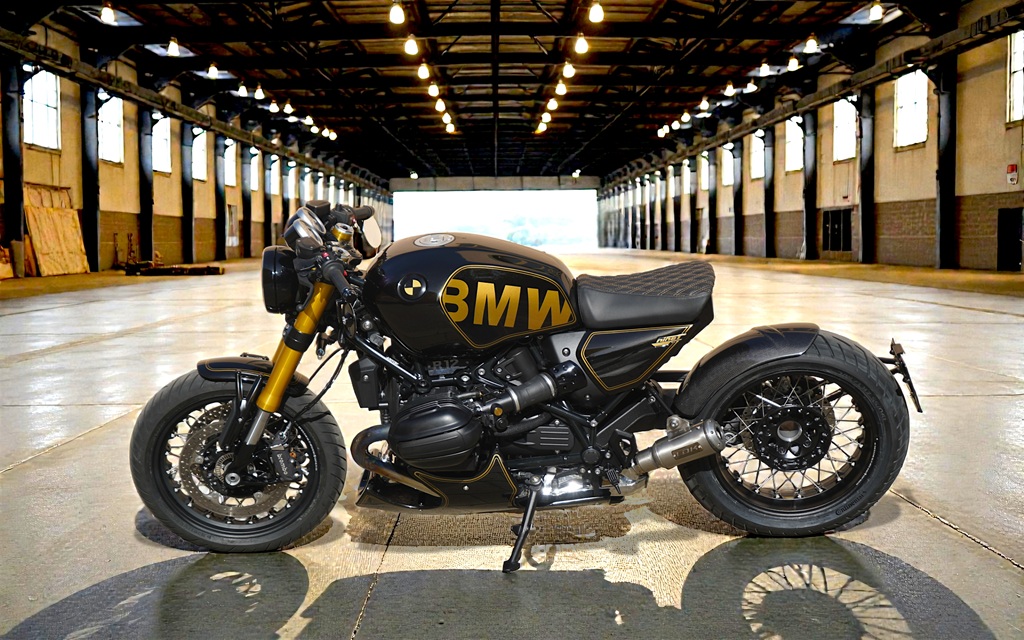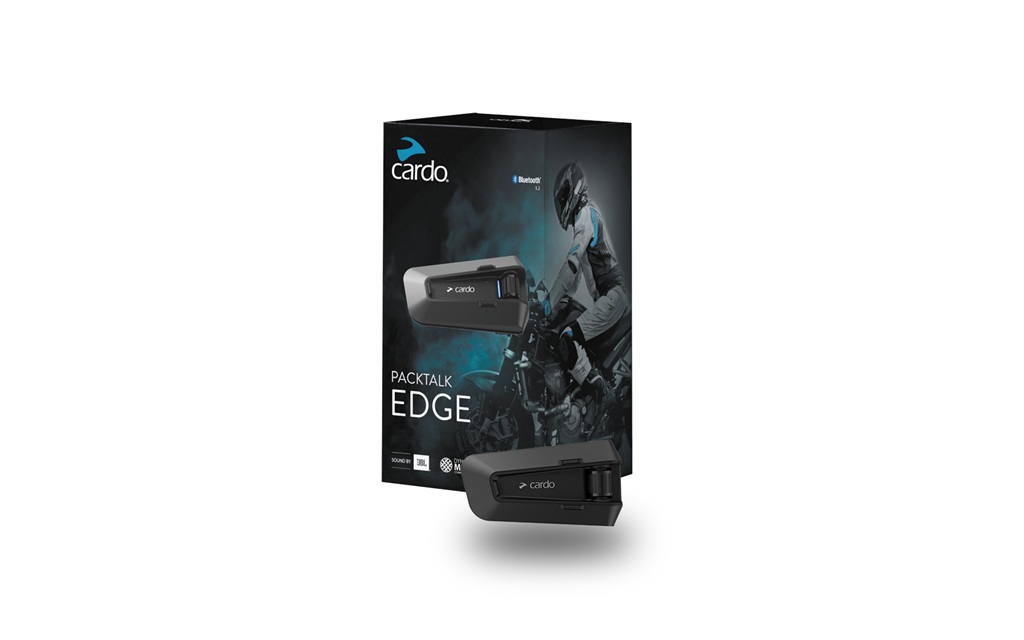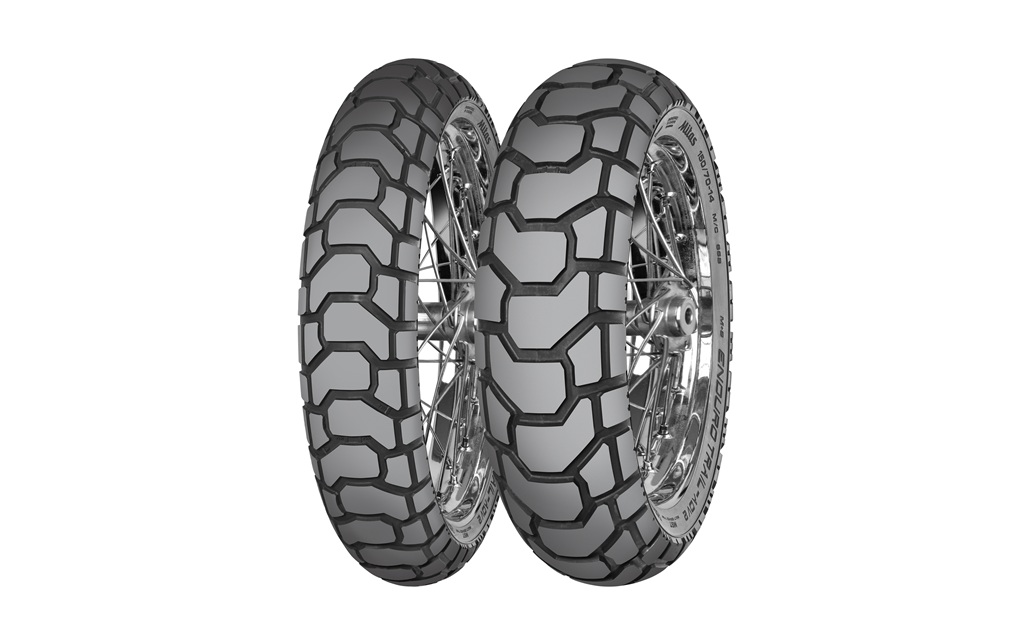During my stay in Savannah for the launch of Royal Enfield’s Classic 350, I had the chance to spend a few hours with a Himalayan model, a very endearing minimalist adventure bike.
The day after the press launch of the Classic 350, I had my morning off – my plane would not takeoff from Savannah before 1:30 PM. Hanging around in front of the hotel, I watched influencers and other ambassadors of the brand getting ready for their riding day on the Classic. Then, I noticed a Himalayan left on its own. Abandoned or simply snubbed out? Maybe because of its pine green camouflage paint? Who knows…
Being renowned for my highly empathic nature, I immediately took pity on the neglected machine. So I went right to the media service manager and asked her if I could take the Himalayan out for a quick bucolic ride around Savannah. That way, it wouldn’t feel so lonely or rejected. Contrary to the day before, I would be alone, following my own rhythm on a carefully chosen riding route. I wanted to maximize the few hours I had in hand to discover the little adventure bike.
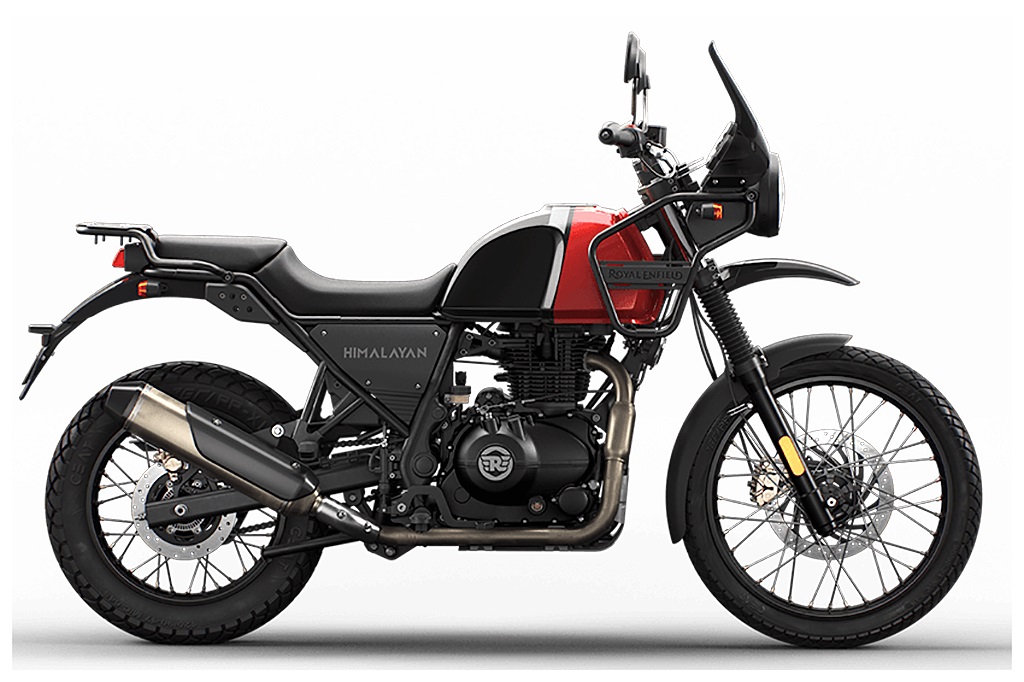
From the roof of the world to South Pole
Presented in 2016 on the Indian market, the Royal Enfield Himalayan appears to be a UFO in the contemporary motorcycle market. This basic adventure bike, powered by a modest air-/oil-cooled 411 cc single cylinder engine, was initially solely aimed at the local market. But with its timeless adventure styling, simplicity and incredibly low price, it became extremely popular on social media – and thus highly desirable. That led Royal Enfield to offer the Himalayan on the global market just two years later, in 2018. The success was immediate in Europe (in England, it became the fourth best-selling bike in the 250-750 cc category), but also in North America. Krishnan Ramaswamy, president of Royal Enfield North America, confirms: “The Himalayan now represents more than 40% of our sales in North America. That’s a major success!” A mostly unexpected success, indeed. Because smaller displacement bikes, even if they fit in the trendy category of adventure bikes, have never been very popular this side of the Atlantic.
An aura of sturdiness and indestructibility radiates from the Himalayan. It’s mechanically simple and easy to fix, even with basic tools. This machine can take you to the end of the world and back, as demonstrated British Jack Grove who went round the globe on a Himalayan. In India, the basic machine took thousands of adventure riders on the roads of the roof of the world without any major problems. Last November, two employees of Royal Enfield – Santhosh Vijay Kumar and Dean Coxson – rode their Himalayans in an expedition named 90° South. They covered 400 kilometres in 28 days through Antarctica until they reached the South Pole, riding in temperatures of -30 Celsius and winds of more than 60 km/h. A first!
The Himalayan can take on any challenge. It will stop at nothing. Just make the first step out and then take your time.
Praise the minimalist lifestyle
Visually, the Himalayan sports a utilitarian, almost spartan look, kind of like Kawasaki’s KLR650 Adventure, with which it shares the same spirit, the same vision of adventure riding. The same simplicity, too.
The lateral protection bars upfront serve a dual function: they protect the gas tank in the event of a fall, and they serve as anchoring points for auxiliary jerrycans. They can even be used to hold mini bags for stuffing things you want to access rapidly or frequently. Compared to the previous model, the bars have been shortened by 90 mm and repositioned to offer more leg room for taller pilots.
The rear rack is now fitted with an extra plate to support heavier loads. It’s also slightly shorter for a better fit with the rear part of the seat and to allow the driver to swing his leg more easily over the bike without tripping his foot.
The aluminum skid plate protecting the base of the engine is a little skinny. If you plan to ride off-road on a regular basis, it would be a good idea to replace it with a sturdier model, and to install robust engine protection bars.
The seat of the Himalayan is low and it’s now fitted with an improved foam padding with a new suede cloth covering that offers more grip to reduce sliding around. The small windshield is slightly higher and wider than on the previous model, in order to better control the airflow.
The all-new counterbalancer-equipped single has a displacement of 411 cc. It meets the BS6 Indian antipollution standard, which is more demanding than the Euro5, so it easily conforms to the latter. The mill is derived from the J-series engine that also powers the Meteor 350 and Classic 350. It puts out 24.3 hp at 6,500 rpm, and a torque of 23.6 lb-ft at 4,500 rpm. The engine breathes through a modern electronic fuel injection system and the burnt gases produce a nice sound going out of the exhaust. The five-speed constant mesh gearbox is linked to a multidisc wet clutch, and power is delivered to the rear wheel by a chain.
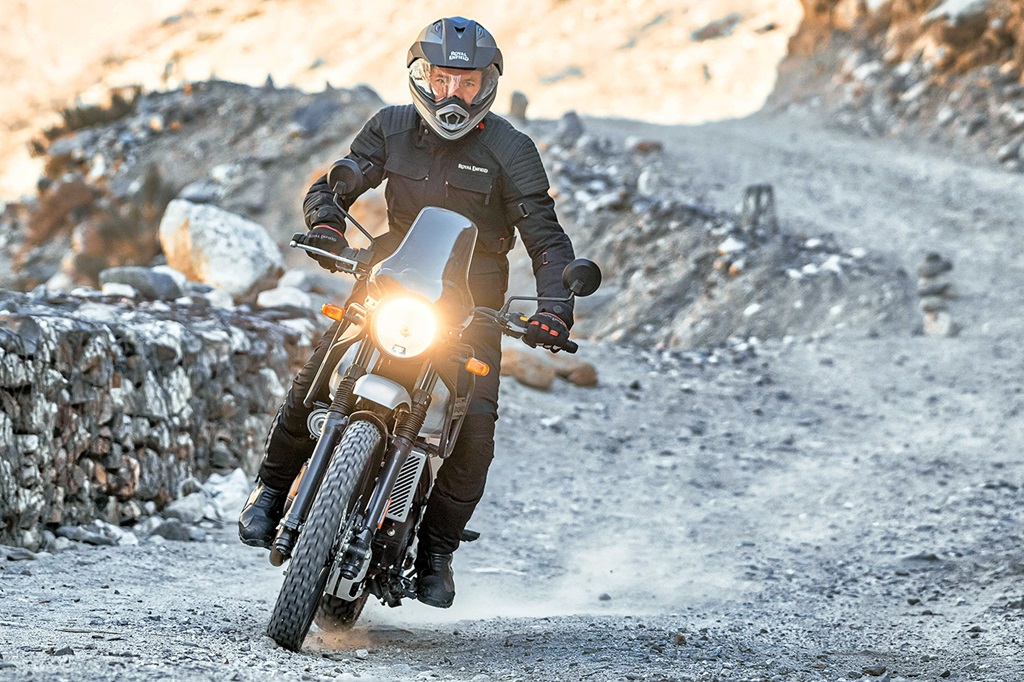
On the road in Dixieland
Taking place on the Himalayan, you quickly feel at ease and confident. The 800 mm seat allows a medium height pilot (1.77 mm in my case) to easily put both feet firmly on the ground. What’s more, it’s relatively comfortable, which is always a plus.
The riding position is relaxed, with your back straight, arms slightly bent and legs in a natural position. The lateral luggage racks each side of the gas tank do not interfere with the legs when seated or when riding standing on the pegs.
The instrumentation is simple but complete. There is a big round analog speedometer, numbered up to 160 km/h, on the left side, and a small tachometer on the right. Just below it, there is a fuel gauge and a compass. Further right, there’s another round instrument that displays the Tripper navigation system, exclusive to Royal Enfield. Built around the Google Maps platform, it’s a simple and intuitive navigation system that connects to your smartphone, through a Royal Enfield application, to show you the way, turn by turn. Simple, but essential.
The reasonable curb weight of 199 kg and relatively low centre of gravity contribute in making the Himalayan easy to accustom to. The high and wide bars make it easy to steer. Just push either grip and it goes where you want, effortlessly. On Georgia and South Carolina’s back roads, I enjoyed its manoeuvrability and liveliness. It’s agile in tight turns – there are not many of these in this part of the United States, but I did find a few – and stays stable in faster curves too.
The moderately knobby dual-purpose CEAT Zoom Plus tires (90/90-21 front, 20/90-17 rear) are mounted on non-tubeless wire-spoked wheels. They deliver acceptable grip and I had no complaints to speak of during my brief encounter with the Indian machine. However, if I were to buy one, I would certainly replace them with Continental TKC70 or Pirelli MT60; these are tires I know well and have full confidence in. That being said, this is a matter of personal preference more than anything else.
On my way, I had the opportunity to ride on a hard-packed trail with a few sandy sections, alongside a bucolic river, to try out the little Indian adventure bike off-road, and I was pleasantly surprised. The 21-inch front wheel flies over obstacles with ease and the 17-inch rear wheel delivers good traction. Going around water puddles and other obstacles is child’s play. In this environment, the suspensions have a tendency to bottom out over big bumps or under hard compression, and the ground clearance can turn out to be somewhat limited when going over major obstacles.
On paved roads, the suspension is comfortable; travel is 200 mm upfront, and 180 mm at the rear. The 41 mm fork is not adjustable. It does not dive too much when braking and it absorbs bumps pretty well, at least on the road. The linkage monoshock, adjustable for spring preload, is a tad firm, but that does not affect the comfort of the machine.
Slowing down is taken care of by a single 300 mm disc with double piston caliper upfront, and a single 240 mm rear disc with single piston caliper. Braking power is adequate, with a linear and very predictable response. You simply have to apply a strong and steady pressure to get a forceful braking.
With its limited power compared to other 4-stroke single adventure bikes – such as the Honda CRF 300 Rallye (30 hp), BMW G 310 GS (34 hp), Kawasaki KLR 650 Adventure (41 hp) or KTM 390 Adventure (43.5 hp) —, the Himalayan barely reaches a top speed of 130 km/h (going downhill with a back wind). That means it’s still fast enough to step on our 100 km/h limited highways, but it’s more in its element on secondary roads and trails.
The surprising tractability of the long stroke single makes it very user-friendly at low-revs. It accelerates from under 2,000 rpm without complaining and you can takeoff with the throttle barely twisted in second and even in third gear. Clutch action is fluid and the friction point is easy to manage. That makes the Himalayan very functional for tight city manoeuvers, but also for off-road riding.
The five-speed gearbox is smooth and precise, and the injection system generates clean accelerations, without any gaps or hesitations. At 115 km/h in fifth gear, the single gently purrs at 5,600 rpm. At this engine speed, the vibrations are well under control and never intrusive. In fact, they contribute to the character of the Royal infield. The red zone begins at 6,500 rpm. The Himalayan accelerates fairly quickly up to 100 km/h, and then needs more time to reach and keep its top speed. The fairing, though minimalist, does a good job at directing the airflow away from the torso and the head of the pilot.
What’s more, the low fuel consumption – 3.5 km/L – gives an impressive range of 440 km, so you can ride and ride without having to stop at a gas station. Plus, you save money…
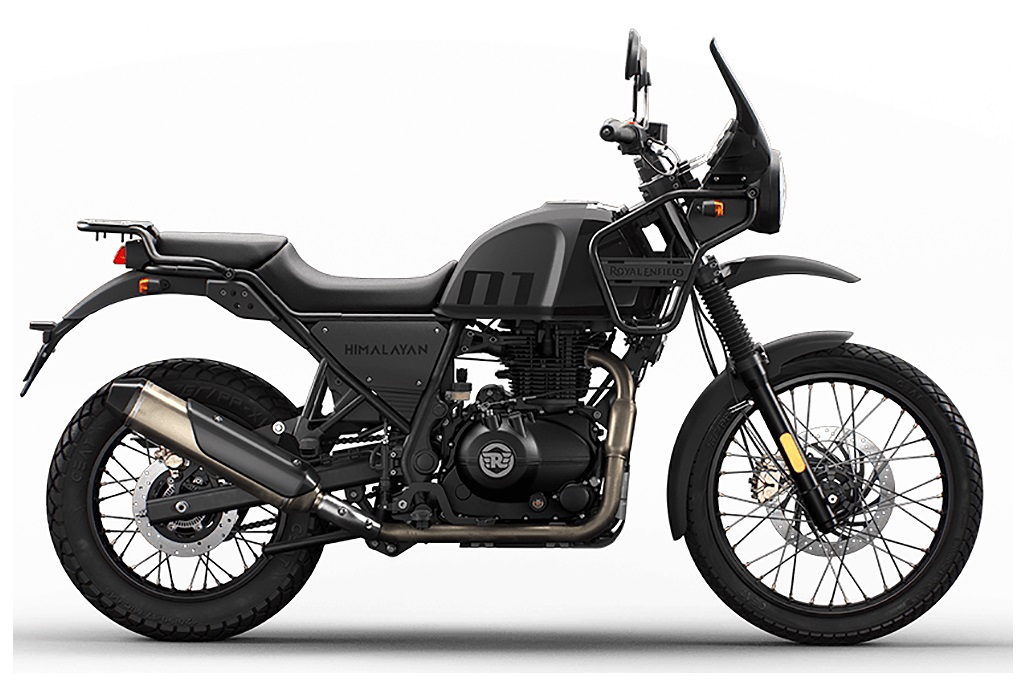
A surprising adventure bike
Even if my encounter with Royal Enfield’s Himalayan was brief – too brief – it was intense and rewarding. I still love riding fast, but I also really appreciated the discreet charm of the Himalayan and its ability to make me travel at a quieter pace, taking time to enjoy the landscape and the riding experience. And considering the repressive and restrictive driving environment in which we’ve been living for the last few years, slowing down appears as a wise decision.
The Himalayan is not only attractive because of its retro adventure bike look, but also because of its general balance, simplicity and ability to adapt to different environments, on or off road.
This is an efficient and endearing dual purpose bike that’s capable of taking any challenge you throw at it. If it can cross the Himalaya, reach the South Pole in the heart of winter and take people around the globe, there’s nothing to stop it. It’s an ideal motorcycle for pilots with an adventurous spirit, a high sense of aesthetics and a taste for things that are different.
I am looking forward to taking the Himalayan out again for a more complete test, or even for an expedition of a few weeks next summer. We’ll see what the future has in store for us.
As with all Royal Enfield models, the Himalayan comes with a three-year, unlimited kilometre warranty that includes roadside assistance. With its price tag of $6,694, it’s quite a bargain!
To learn more, visit the Royal Enfield Canada Website.
SPECIFICATIONS
GENERAL DATA
Wet weight: 199 kg
Seat height: 800 mm
Fuel capacity: 15 L
Fuel consumption: 3.50 L/100 km
Fuel range: 440 km
Colours: Mirage Silver, Granite Black, Rock Red, Lake Blue, Gravel Grey, Pine Green
Price: $6,694
ENGINE
Engine type: SOHC 2-valve four-stroke single, air/oil-cooled, Euro 5
Maximum power: 24.3 hp at 6,500 rpm
Maximum power: 23.6 lb-ft at 4,500 rpm
Displacement: 411 cc
Bore x stroke: 78 x 86 mm
Compression ratio: 9.5:1
Carburation: electronic fuel injection system
Transmission: 5-speed
Final drive: chain
CHASSIS
Tubular steel frame
Suspension: 41 mm telescopic fork, non-adjustable, 200 mm travel; linkage monoshock, adjustable for preload, 180 mm travel
Wheelbase: 1,465 mm
Rake/trail: 26 degrees/111 mm
Brakes: single 300 mm front disc with ByBre 2-piston caliper; single 240 mm rear disc with single-piston caliper. Dual Channel ABS, switchable at the rear wheel
Tires: CEAT Zoom Plus; 90/90-21 front; 120/90 -17 rear
QUICK VERDICT
WE LIKED
Great vintage look
Simplicity
Neutral and balanced behaviour
Fine evocative aura
WE LIKED LESS
Modest performance of the engine
Ground clearance is a little tight
The stock tires (CEAT)
